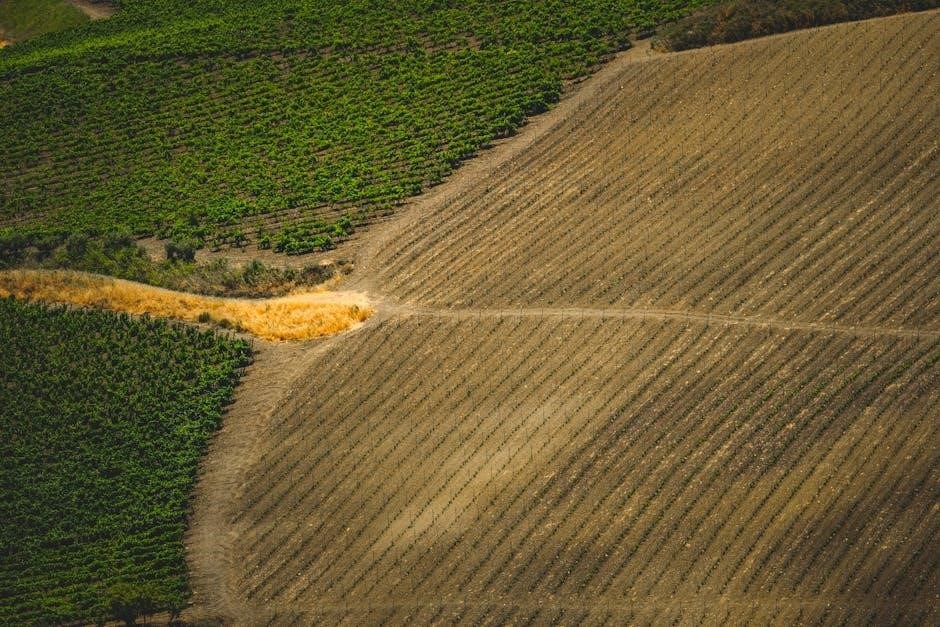The Hy-Line Brown Layer Management Guide is essential for effective layer farming, offering comprehensive strategies to maximize flock performance through proper chick management, nutrition, health, and lighting programs.
1.1 Overview of Hy-Line Brown Layers
The Hy-Line Brown layer is a high-performing breed known for its adaptability to various production systems, including free-range and cage environments. Renowned for their calm temperament, excellent feather retention, and robust egg production, these birds are ideal for commercial egg production. Their strong eggshells and consistent laying performance make them a preferred choice for farmers worldwide. The Hy-Line Brown strain is specifically bred to thrive in diverse conditions, ensuring optimal productivity and durability in both intensive and alternative farming setups.

1.2 Importance of Proper Management Practices
Proper management practices are crucial to unlock the full genetic potential of Hy-Line Brown layers. Effective strategies ensure optimal health, productivity, and egg quality. Without adherence to best practices, issues like reduced egg production, health complications, and increased mortality rates may arise. Implementing tailored nutrition, biosecurity, and lighting programs maximizes performance and ensures long-term profitability. Consistent monitoring and adaptation to environmental conditions further enhance overall efficiency, making proper management indispensable for sustainable and successful layer farming operations.

Commercial Management Guide for Hy-Line Brown Layers
The Hy-Line Brown Commercial Management Guide provides essential strategies for optimizing layer performance, covering nutrition, health, and environmental practices, updated regularly with new insights.
2.1 Key Components of the Commercial Management Guide
The commercial management guide for Hy-Line Brown layers includes detailed strategies for chick management, nutrition, health, and lighting programs. It emphasizes proper brooding systems, vaccination schedules, and phase feeding to optimize egg production. The guide also covers disease prevention, parasite control, and biosecurity measures. Lighting intensity and duration are addressed to enhance productivity. Regular updates ensure the guide reflects the latest genetic advancements and field experiences, providing a comprehensive resource for achieving optimal flock performance in various production systems.
2.2 Differences Between Hy-Line Brown and Hy-Line W-80 Management
Hy-Line Brown and Hy-Line W-80 layers have distinct management requirements. Hy-Line Browns are ideal for free-range systems due to their calm temperament and robust feather retention, while Hy-Line W-80s are better suited for cage systems. Browns require slightly higher light intensity for optimal production, whereas W-80s adapt well to controlled environments. Feeding strategies also differ, with Browns benefiting from phase feeding to manage egg size, while W-80s focus on consistent nutrient intake for sustained production. These differences ensure each strain thrives in their respective production systems.

Chick Management for Hy-Line Brown Layers
Hy-Line Brown chicks adapt well to both floor and cage brooding systems, requiring proper temperature, humidity, and vaccination for optimal growth.
3.1 Brooding Systems and Requirements
Hy-Line Brown chicks thrive in both floor and cage brooding systems, requiring consistent temperature management starting at 90°F and gradually decreasing. Proper ventilation is essential to prevent ammonia buildup. Maintain humidity at 50-60% during the first week to ensure chick comfort. Lighting should be bright and evenly distributed to avoid shadows. Vaccination against Marek’s disease is critical. No special hatchery services are needed beyond standard vaccination protocols. These conditions ensure healthy growth and optimal development during the brooding phase.
3.2 Vaccination Programs for Optimal Health
Vaccination is critical for maintaining the health of Hy-Line Brown layers. Chicks should be vaccinated against Marek’s disease at the hatchery to prevent this highly contagious virus. Additional vaccinations may include protection against infectious bronchitis and Newcastle disease, depending on regional health risks. A well-planned vaccination program ensures robust immune systems and reduces mortality rates. Biosecurity measures, such as proper sanitation and pest control, further complement vaccination efforts to promote overall flock health and productivity throughout the production cycle.

Nutrition and Feeding Strategies
Nutrition is vital for optimal egg production and health in Hy-Line Brown layers. Phase feeding strategies ensure balanced diets tailored to egg production stages, promoting egg quality and flock longevity.
4.1 Phase Feeding for Egg Size Management
Phase feeding is crucial for managing egg size in Hy-Line Brown layers. It involves adjusting dietary protein levels to balance egg size and production. After 40 weeks, phase feeding limits protein to control egg size, ensuring uniformity; This strategy optimizes nutrition, reduces costs, and maintains flock health. Proper implementation of phase feeding, as outlined in the Hy-Line Brown Management Guide, ensures consistent egg quality and maximizes production efficiency throughout the laying cycle.
4.2 Nutritional Recommendations for Different Production Stages
Nutritional needs vary across production stages for Hy-Line Brown layers. Pullets require higher protein for growth, while laying hens need balanced calcium, phosphorus, and vitamins for eggshell quality. Mature hens benefit from adjusted protein levels to sustain egg production. The Hy-Line Brown Management Guide provides stage-specific dietary recommendations to optimize health, egg quality, and flock performance, ensuring nutrients are tailored to support each phase of development and production effectively.

Health Management and Disease Control
Effective health management for Hy-Line Brown layers involves biosecurity measures, vaccination programs, and parasite control to ensure flock well-being and productivity, preventing disease outbreaks and promoting longevity.
5.1 Biosecurity Measures to Prevent Disease
Biosecurity is critical for maintaining healthy Hy-Line Brown flocks. Essential measures include proper sanitation, disinfection of equipment, and restricting access to authorized personnel. Eliminating drafts, maintaining optimal humidity levels, and ensuring cleanliness in housing are vital. Implementing effective rodent and pest control programs further reduces disease risks. Proper feed storage and handling also play a key role in preventing contamination. These practices help create a disease-free environment, ensuring the flock’s health and productivity are maximized throughout the production cycle.
5.2 Parasite Control and Monitoring Programs
Effective parasite control is crucial for maintaining the health and productivity of Hy-Line Brown layers. Regular monitoring programs should be implemented to detect internal and external parasites early. Proper cleaning, disinfection, and sanitation of housing systems are essential to minimize parasite risks. Maintaining a clean litter environment and ensuring dry conditions can significantly reduce the prevalence of parasites. Additionally, strategic use of anthelmintic treatments, when necessary, helps protect the flock from parasitic infections, ensuring optimal health and performance throughout the production cycle.
Lighting Programs for Hy-Line Brown Layers
Lighting programs for Hy-Line Brown layers should provide consistent intensity and duration to optimize egg production and welfare. Bright light (20 lux) is recommended to avoid shadows.
6.1 Light Stimulation Based on Body Weight
Light stimulation for Hy-Line Brown layers is now based on body weight rather than age, ensuring optimal physiological development. A 7-week step-down program helps achieve peak production efficiently. This approach aligns lighting intensity with the flock’s growth stage, promoting consistent egg size and production. Proper timing and intensity adjustments ensure energy efficiency and bird welfare, contributing to overall performance and profitability in layer farming operations.
6.2 Recommended Lighting Intensity and Duration

Hy-Line Brown layers require a minimum lighting intensity of 20 lux (2 foot-candles) during production. Light duration should gradually increase from 14 to 16 hours per day by 40 weeks of age. Consistent light distribution is crucial to avoid shadows, which can stress birds. The lighting program should align with flock age and productivity, ensuring energy efficiency while maintaining egg production and bird welfare. Proper light management enhances overall performance and profitability in layer farming systems.

Performance Optimization and Target Metrics
The Hy-Line Brown Management Guide emphasizes optimizing flock performance through genetic potential, nutrition, and health. Target metrics include peak egg production, egg size, and overall flock longevity.
7.1 Egg Production and Quality Standards
The Hy-Line Brown layer is renowned for its high egg production and consistent quality. Hens typically achieve over 300 eggs per year, with excellent shell strength and size uniformity. Proper nutrition and phase feeding strategies are critical to maintaining egg size and quality, especially after 40 weeks of age. The management guide provides specific targets for egg production, shell quality, and size distribution, ensuring optimal performance and meeting market demands effectively.
7.2 Factors Affecting Flock Performance
Several factors influence the performance of Hy-Line Brown layers, including nutrition, lighting programs, health management, and genetic potential. Proper feeding strategies, phase feeding, and adherence to recommended nutritional guidelines are essential for optimal egg production. Lighting intensity and duration also play a crucial role in stimulating egg laying. Additionally, the flock’s temperament and environmental conditions, such as stress levels and biosecurity measures, significantly impact overall performance. Regular monitoring and adherence to management guidelines ensure maximum productivity and egg quality.

Accessing and Utilizing the Management Guide
The Hy-Line Brown Management Guide PDF can be downloaded via official Hy-Line links, offering detailed strategies and updates to optimize flock performance and egg production effectively.
8.1 How to Download the Hy-Line Brown Management Guide PDF
To download the Hy-Line Brown Management Guide PDF, visit the official Hy-Line website and navigate to the resources or support section. Click on the provided link for the Hy-Line Brown Management Guide, and follow the prompts to download the PDF. Ensure you have a stable internet connection for a smooth download. The guide is available free of charge and offers detailed insights into optimizing flock performance, nutrition, and health management for Hy-Line Brown layers.
8.2 Technical Support and Updates from Hy-Line
Hy-Line provides dedicated technical support to ensure optimal performance of your flock. Customers can access updates, troubleshooting guides, and best practices through the Hy-Line website or by contacting their customer service team. Regular updates are released to reflect the latest genetic advancements, nutritional recommendations, and management strategies. Additionally, Hy-Line offers online resources, webinars, and technical bulletins to keep producers informed about the latest developments in layer management. This support ensures producers can maximize the genetic potential of their Hy-Line Brown layers effectively.